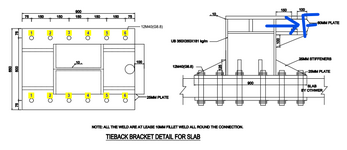Michael Val
Civil/Environmental
- May 6, 2025
- 3
Hello everyone, I could use your expertise. I'm working with through bolts anchored in a concrete slab, and I'm referencing Eurocode for design. Unfortunately, there’s limited guidance available for this specific case.
Here’s the situation (please refer to the image below):


green - beams
yellow - slab
I'm only concerned with the concrete slab—not the bolt or base plate. Based on my understanding, I need to check for the following failure modes:
Concrete cone failure due to tension from moment
Concrete pry-out failure
Concrete bearing compression
Am I on the right track?
I also have additional questions:
Here’s the situation (please refer to the image below):


green - beams
yellow - slab
I'm only concerned with the concrete slab—not the bolt or base plate. Based on my understanding, I need to check for the following failure modes:
Concrete cone failure due to tension from moment
Concrete pry-out failure
Concrete bearing compression
Am I on the right track?
I also have additional questions:
- Edge Distance
 : If the anchor is placed in the middle of a slab bounded by beams, how should I treat edge distance? Can I assume the edge effects (like blow-out failure) are negligible, or do I need to account for them?
: If the anchor is placed in the middle of a slab bounded by beams, how should I treat edge distance? Can I assume the edge effects (like blow-out failure) are negligible, or do I need to account for them? - Eccentricity
 : Since the tension arises from moment, should I be concerned about eccentric loading effects on the anchor?
: Since the tension arises from moment, should I be concerned about eccentric loading effects on the anchor?
